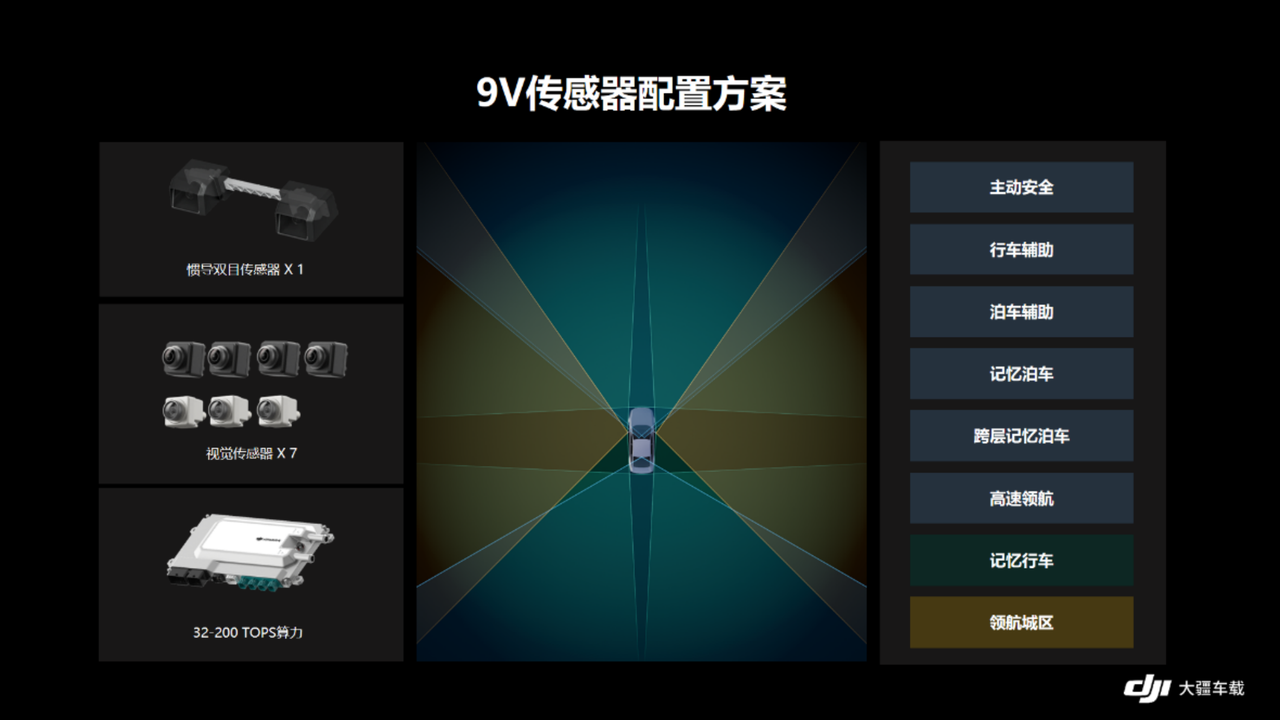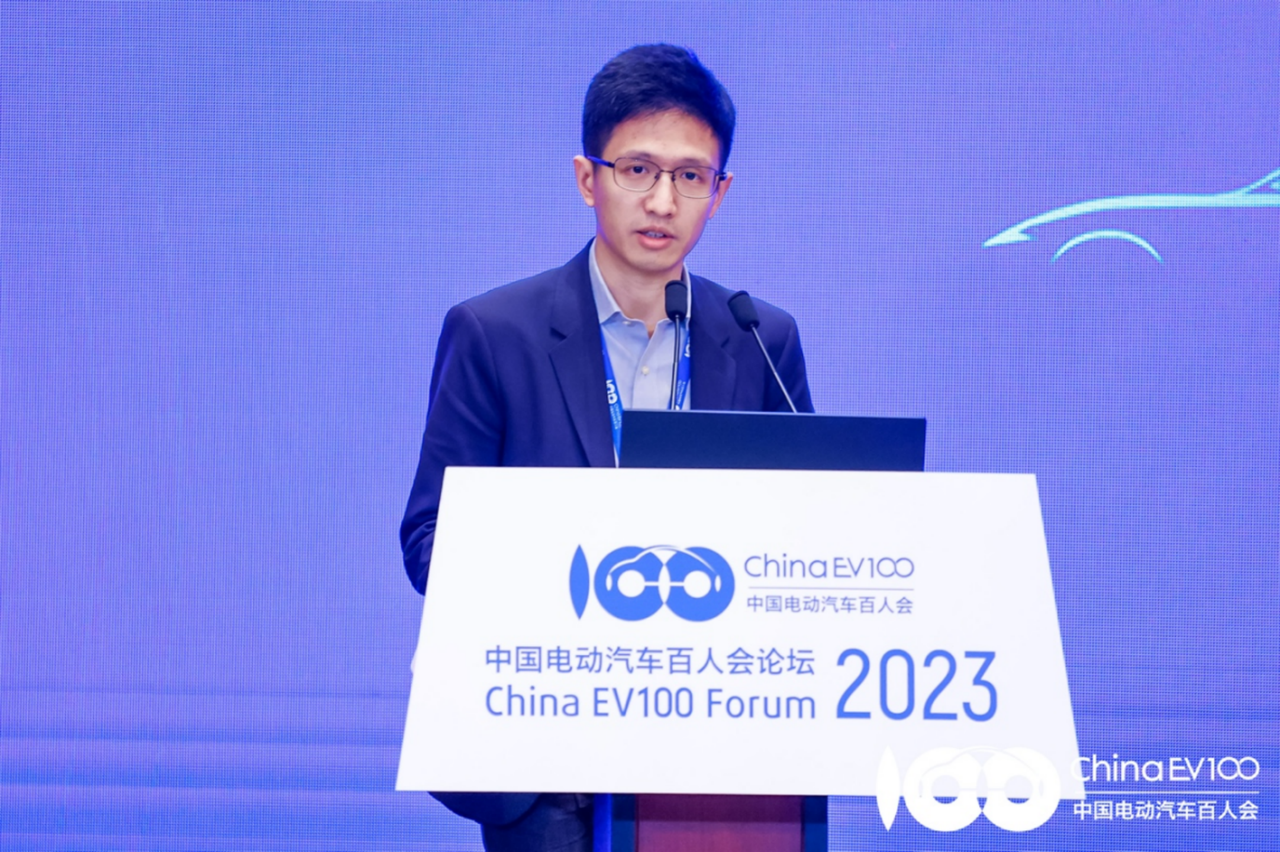Recently, DJI Automotive announced their latest generation of intelligent driving solutions at the China Electric Vehicle 100 Forum (2023).
The solution’s features include a low 32 TOPS computing power and a 7V/9V vision-only configuration, achieving L2+ intelligent driving capabilities such as urban memory driving (32 TOPS) and urban navigation driving (80 TOPS) through “strong real-time visual perception, no reliance on high-precision maps, and no dependence on LiDAR.” Additionally, the vision-assisted driving system supports expansion with millimeter-wave radar, ultrasonic radar, LiDAR, and high-precision maps to enhance system redundancy for safety.
Specifically, DJI Automotive’s new generation intelligent driving solution has the following characteristics:
- Low computing power threshold, robust algorithms: Efficiently achieving various intelligent driving functions with as low as 32 TOPS computing power;
- Rich functionality: Capable of active safety, driving assistance, parking assistance, memory parking, cross-layer memory parking, memory driving, and high-speed navigation driving; with an upgraded configuration, it can achieve urban navigation driving;
- Efficient and straightforward sensor configuration: The basic configuration is 7V, including a pair of DJI Automotive’s unique front-facing inertial stereo binocular cameras, one rear-view monocular camera, and four surround-view fisheye cameras; with powerful real-time visual perception and decision-making and planning abilities, it can achieve all functionalities except urban navigation driving without relying on high-precision maps (urban navigation driving can be realized with high-precision maps);
- Raising computing power to 80 TOPS and adding two side-view monocular cameras, upgrading to a 9V configuration, can enhance the ability to detect dynamic vehicles on both sides, fulfilling observation needs at intersections for left and right turns, U-turns, and roundabouts, achieving all intelligent driving functions, including urban navigation driving, without relying on high-precision maps;
- Strong expandability: The solution supports expanding computing power to 200 TOPS, as well as extending millimeter-wave radar, ultrasonic radar, LiDAR, and high-precision maps sensors to enhance system redundancy for safety and elevate high-order L2+ features like high-speed navigation and urban navigation experiences.
This solution offers a variety of tiered configurations, providing upgraded high-order intelligent functions for entry-level vehicles and more satisfying intelligent driving experiences for mid-to-high-end vehicles. The mass production cost of different configurations can reasonably cover the demands of mainstream models priced between 100,000-300,000 yuan while allowing customization for high-end models.The following Markdown Chinese text translated into English Markdown text, maintaining the HTML tags in the Markdown, and only outputting the result:
It is understood that the solution is currently in a usable state and is actively promoting mass production with cooperative vehicle manufacturers.
It is worth mentioning that DJI Automotive also revealed during the forum event that it is currently preparing for a higher level of intelligent driving. DJI Automotive stated that by achieving core intelligent driving functions with a basic hardware architecture, reducing the dependence on external data and expensive sensors, and minimizing assumptions about the real-world environment, they are paving the way towards a higher level of intelligent driving.

How does DJI Automotive become a leading intelligent driving tier1 supplier?
It is understood that the DJI Automotive team started exploring the application of mobile robot technology in the automotive field in 2016, and the “DJI Automotive” business brand officially made its debut in 2021, positioning itself as an intelligent driving tier1 supplier.
DJI Automotive’s solution showcases the characteristics of “achieving core intelligent driving functions with a basic hardware architecture,” and is constantly evolving towards a higher-level intelligent driving experience along the path of “strong real-time online visual perception, weak dependence on high-precision maps, and few real-world assumptions,” making it more suitable for best-selling vehicles in the Chinese market.
Specifically, DJI Automotive’s approach is:
-
Experience-driven: DJI Automotive is fundamentally focused on delivering the best end-user experience, avoiding unnecessary hardware stacking that does not enhance the experience for vehicle manufacturers and consumers, and instead focusing on breakthroughs in computing power, algorithms, sensors, and data.
-
Hardware reuse across multiple scenarios: DJI Automotive believes that a high-quality L2+ experience must integrate both driving and parking, with the same set of hardware handling intelligent driving requirements in different scenarios, rather than having parking hardware sit idle when driving and driving hardware and sensors idle when parking.
-
Maximizing hardware potential: DJI Automotive’s unique front-view inertial stereo vision system, which leverages a human-like visual principle to obtain distance information, generating dense point clouds and recognizing any category of obstacles. Together with other visual sensors and extreme algorithm optimization, all available perception information and computing power are efficiently utilized. DJI Automotive’s latest generation of intelligent driving solutions also features hardware upgrades compared to the previous generation (the new stereo system eliminates the need for a large sunshade and fixed connector by adding a polarizing sheet and self-calibration capabilities), further enhancing performance while reducing mass production costs.- Minimized dependency, fewer assumptions: DJI Automotive deeply understands that the real world differs from the ideal state on digital maps, and assuming ideal conditions can’t handle various complexities. Thus, DJI Automotive emphasizes mastering the “basics” of autonomous driving, relying on fundamental hardware architecture to enable core functions, reducing dependence on external data and pricey sensors, and minimizing assumptions about the environment.
-
As for costs, DJI Automotive believes that a 5% – 8% total cost of L2+ autonomous driving systems in relation to the vehicle’s sale price is reasonable: below 5%, performance would be too low, being difficult to utilize in practice; above 8%, both cost control for automakers and consumer purchasing willingness would be challenged, impeding the popularization of autonomous driving.
-
Therefore, based on the main selling prices of vehicles in the Chinese market, DJI Automotive deems a cost range of ¥5,000 to ¥15,000 for L2+ autonomous driving systems as necessary to deliver a high-quality L2+ driving experience, paving the way for iterative advancements towards higher-level autonomy given the larger cost margins.
-
DJI Automotive states that it will continually expand the breadth and depth of its collaborations within the intelligent vehicle industry, fulfilling its role as an autonomous driving tier-1 supplier, and creating value for industry partners.
This article is a translation by ChatGPT of a Chinese report from 42HOW. If you have any questions about it, please email bd@42how.com.
